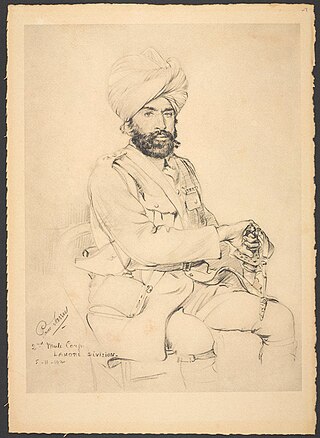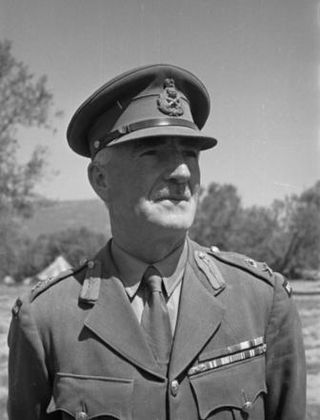Related Research Articles
The British Expeditionary Force (BEF) was the six-divisions the British Army sent to the Western Front during the First World War. Planning for a British Expeditionary Force began with the 1906–1912 Haldane Reforms of the British Army carried out by the Secretary of State for War Richard Haldane following the Second Boer War (1899–1902).

The New Zealand and Australian Division was a composite army division raised for service in the First World War under the command of Major General Alexander Godley. Consisting of several mounted and standard infantry brigades from both New Zealand and Australia, it served in the Gallipoli Campaign between April and December 1915.

The New Zealand Expeditionary Force (NZEF) was the title of the military forces sent from New Zealand to fight alongside other British Empire and Dominion troops during World War I (1914–1918) and World War II (1939–1945). Ultimately, the NZEF of World War I became known as the First New Zealand Expeditionary Force. The NZEF of World War II was known as the Second New Zealand Expeditionary Force (2NZEF).

The Australian and New Zealand Army Corps (ANZAC) was originally a First World War army corps of the Mediterranean Expeditionary Force. It was formed in Egypt in December 1914, and operated during the Gallipoli campaign. General William Birdwood commanded the corps, which primarily consisted of troops from the First Australian Imperial Force and 1st New Zealand Expeditionary Force, although there were also British and Indian units attached at times throughout the campaign. The corps disbanded in 1916, following the Allied evacuation of the Gallipoli peninsula and the formation of I ANZAC Corps and II ANZAC Corps. The corps was reestablished, briefly, in the Second World War during the Battle of Greece in 1941. The term 'ANZAC' has been used since for joint Australian–New Zealand units of different sizes.

Samuel Frickleton, was a soldier in the New Zealand Military Forces and a recipient of the Victoria Cross (VC), the highest award of the British Commonwealth for gallantry in the face of the enemy.
Archibald McColl Learmond Baxter was a New Zealand socialist, pacifist and conscientious objector.

The New Zealand Rifle Brigade (Earl of Liverpool's Own), affectionately known as The Dinks, was formed on 1 May 1915 as the third brigade of the New Zealand Division, part of the New Zealand Expeditionary Force. During the First World War it fought in Egypt, against the Senussi, and then on the Western Front. It was disbanded on 4 February 1919.

The military history of New Zealand during World War I began in August 1914. When Britain declared war on Germany at the start of the First World War, the New Zealand Government followed without hesitation, despite its geographic isolation and small population. It was believed at the time that any declaration of war by the United Kingdom automatically included New Zealand; and the Governor announced that New Zealand was at war with Germany from the steps of Parliament on 5 August.

The Otago Infantry Regiment was a military unit that served within the New Zealand Expeditionary Force (NZEF) in World War I during the Gallipoli Campaign (1915) and on the Western Front (1916–1919). This Regiment and the Otago Mounted Rifles Regiment were composed mostly of men from Otago and Southland. The Otago Infantry Regiment represented the continuation of the Dunedin and Invercargill Militia Battalions formed in 1860.

The 3rd (Lahore) Division was an infantry division of the Indian Army and before 1895, the Bengal Army, first organised in 1852. It saw service during World War I as part of the Indian Corps in France before being moved to the Middle East where it fought against troops of the Ottoman Empire.

The New Zealand Pioneer Battalion (NZPB), later known as the New Zealand (Māori) Pioneer Battalion or New Zealand Māori (Pioneer) Battalion, was a battalion of the New Zealand Expeditionary Force (NZEF) that served during the Great War. The battalion was formed in Egypt in March 1916 upon New Zealand Divisional Orders of 20 February, and drawn from surplus officers and other ranks of the New Zealand Mounted Rifles (NZMR), the Otago Mounted Rifles (OMR) and the New Zealand Native Contingent (NZNC) then serving in Egypt with the New Zealand Infantry Brigade. It consisted of Māori, Pākehā and Pacific Islanders. "By the end of the war, 2227 Maori and 458 Pacific Islanders had served in what became known as the Maori Pioneer Battalion. Of these, 336 died on active service and 734 were wounded. Other Maori enlisted in other units."

The Western Frontier Force was raised from British Empire troops during the Senussi Campaign from November 1915 to February 1917, under the command of the Egyptian Expeditionary Force (EEF). Orders for the formation of the force were issued on 20 November 1915, under Major-General Alexander Wallace, C.B. The force concentrated at Mersa Matruh on the coast and began operations against the Senussi in late 1915.

SS Athenic was a British passenger liner built by Harland & Wolff shipyards for the White Star Line in 1901.

Lieutenant General Sir Edward Puttick, was an officer who served with the New Zealand Military Forces during the First and Second World Wars. The first New Zealand-born soldier to reach the rank of lieutenant general, he was Chief of the General Staff of the New Zealand Military Forces from 1941 to 1945.

Brigadier-General Harry Townsend Fulton, was a British Indian Army officer who served with the New Zealand Military Forces during the Second Boer War and First World War.

RMS Tahiti was a UK Royal Mail Ship, ocean liner and refrigerated cargo ship. She was launched in 1904 in Scotland as RMS Port Kingston for a subsidiary of Elder Dempster Lines. In 1911 the Union Steamship Company of New Zealand bought her and renamed her Tahiti.
Albert Edward Mackay Rowland was a New Zealand athlete who competed in walking events. He competed for Australasia in two walking events at the 1908 Summer Olympics in London.

Geelong was a ship owned by the Blue Anchor Line, and, after 1910, by P&O. She was constructed in 1904 by Barclay, Curle and Co. Ltd., at Glasgow, Scotland. When originally constructed, she had accommodation for 120 saloon and 200 third-class passengers, and also carried cargo. Her gross register tonnage was 7700 tons, and she was 450 feet long, powered by triple-expansion steam engines, and capable of 14 knots, with an average cruise speed of 12 knots.

SS Warrimoo was a passenger and refrigerated cargo liner that was launched in 1892 in England for Australian owners, was later owned by two of New Zealand's foremost shipping companies, and finally belonged to a Singaporean company.

SS Rotorua was a New Zealand Shipping Company steam ocean liner and refrigerated cargo ship that was built in Scotland in 1910 and sunk by a U-boat in 1917.
References
- ↑ "Ship Fact Sheet: Waitemata (1908)" (PDF). P&O Heritage. 2009. Archived from the original (PDF) on 4 October 2015. Retrieved 3 October 2015.
- ↑ "Embarkation of Reinforcements of the NZMR 1914 1918". New Zealand Mounted Rifles Association. Archived from the original on 3 February 2014. Retrieved 2 May 2014.
- ↑ "New Zealand Transport Ships: Waitmata" Archived 14 June 2014 at the Wayback Machine . Flotilla Australia.
- ↑ "Conscientious objectors". NZ Truth. Issue 697. 26 October 1918. p. 1.
- ↑ "Voyage Details: HMNZT 89". Auckland War Memorial Museum. Retrieved 3 October 2015.
- ↑ "SS Waitemata (+1918)". Wrecksite. Retrieved 3 October 2015.
- ↑ "Waitemata". Uboat.net. Retrieved 2 May 2014.